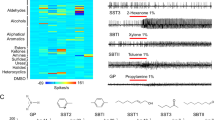Abstract
The behavioural process by which a mosquito finds a potential host organism is mediated by olfactory receptors on the insect’s antennae. Lactic acid (LA) is a host-related odour common to all potential hosts. On the antennae of the female are two LA-sensitive neurons; one of these is excited by LA but the other is inhibited by LA. Furthermore, the sensitivity of the LA-excited neuron is correlated 1:1 with the presence of host-seeking behaviour such that when host-seeking behaviour is inhibited following a blood meal, the sensitivity of the LA-excited neuron is markedly decreased. The inhibition of host-seeking behaviour and the decrease in LA-sensitivity are induced by a hemolymph-borne factor released during oocyte maturation. The source of this factor is the fat body of blood-fed females, which requires a vitellogenic ovary for its production and/or release. The combined activity of the two types of LA-sensitive neurons together with the shift in sensitivity of the LA-excited neuron from a range where host levels of LA are present to a range exceeding LA levels expected from a host are sufficient to account for the inhibition of host-seeking behaviour following a blood meal.
Résumé
La conduite par laquelle le moustique se trouve an hote-organisme potentiel, est entremis par des récepteurs olfactif sur les antennes de l’insecte. Lactique-acide (LA) est un hote-rapport, une odeur commune de l’hote-rapport a tous les hôtes potentiel. Sur l’antenne de la femelle, il y a deux neurons LA-sensitif; seulement un des deux est excite par le LA, mais l’autre est arrête par le LA. En outre, la sensitivitie due neuron LA-excite corresponds 1:1 avec la presence de l’hote-chercheur et sa conduite est tel, que lorsque la conduite de l’hote-chercheur est inhibite après un repas sanguin, la sensitivite du neuron LA-excite est très diminuée. L’inhibition de la conduite de l’hote-chercheur et le decroissement dans la sensitivitie sont introduit par un nouveau agent, hemolymph, qui est décharge pendant la maturite de l’oocyte. La source de cet agent est la graisse des femelles nourrie par le sang, qui demande une ovaire vitellogenique pour sa production et/ou replacement. Les activités combinées de ces deux types: neurons de LA-sensitif avec la difference dans la sensitivite des neurons LA-excite d’un rang depuis un niveau ou les niveaux de l’hote avec le LA sont present a un rang excédant le niveau LA expecte d’un hôte sont suffisant pour expliquer l’inhibition de la conduite de l’hote-chercheur après un repas sanguin.
Similar content being viewed by others
References
Boeckh J., Kaissling K.-E. and Schneider D. (1965) Insect olfactory receptors. Cold Springs Harbour Symp. Quant. Biol. 30, 263–280.
Camhi J. M. (1984) Neuroethology. Sinauer Assoc. Publishers, Sunderland, MA, pp. 259–264.
Davis E. E. (1984a)Development of lactic acid-receptor sensitivity and host-seeking behavior in newly emerged female Aedes aegypti mosquitoes. J. Insect Physiol. 30, 211–215.
Davis E. E. (1984b) Regulation of sensitivity in the peripheral chemoreceptor systems for host-seeking behavior by a haemolymph-borne factor in Aedes aegypti.J. Insect Physiol. 30, 179–183.
Davis E. E. (1984c) Peripheral chemoreceptors and regulation of insect behavior. In Mechanisms in Insect Olfactory Orientation. (Edited by Payne T. L., Birch M. C. and Kennedy C. E. J.) pp. 243–251. Oxford Univ. Press, Oxford.
Davis E. E. (1985) Insect repellents: concepts of their mode of action relative to potential sensory mechanisms in mosquitoes. J. Med. Ent. 22, 237–243.
Davis E. E. and Bowen M. F. (1986) Hormonal regulation of receptor sensitivity and host-seeking behavior in mosquitoes: Role of the fat body. In Host Regulated Developmental Mechanisms in Vector Arthropods. (Borovsky D. and Spielman A.) pp. 135–141. University of Florida, Vero Beach.
Davis E. E. and Sokolove P. G. (1975) Temperature response of the antennal receptors in the mosquito, Aedes aegypti. J. Comp. Physiol. 96, 223–236.
Davis E. E. and Sokolove P. G. (1976) Lactic acid-sensitive receptors on the antennae of the mosquito, Aedes aegypti. J. Comp. Physiol. 105, 43–54.
Dittmer D. D. (1961) Biological handbooks: blood and other body fluids. Fed. Amer. Soc. Exp. Biol., Washington, D.C., pp. 467–473.
Feinsod F. M. and Spielman A. (1979) An olfactometer for measuring host-seeking behavior of female Aedes aegypti. J. Med. Ent. 15, 282–285.
Geddes L. A. and Baker L. E. (1968) Principles of Applied Biomedical Instrumentation. John Wiley and Sons, New York, pp. 365–377.
Kandel E. R., Krasne F. B., Strumwasser F. and Truman J. W. (1979) Cellular mechanisms in the selection and modulation of behavior. Neurosci. Res. Program Bull. 17, 523–710.
Klowden M. J. and Lea A. O. (1979a) Abdominal distention terminates subsequent host-seeking behavior of Aedes aegypti following a blood meal. J. Insect Physiol. 25, 583–585.
Klowden M. J. and Lea A. O. (1979b) Humoral inhibition of host-seeking in Aedes aegypti during oocyte maturation. J. Insect Physiol. 25, 231–235.
Klowden M. J., Davis E. E. and Bowen M. F. (1987) Role of the fat body in the regulation of host-seeking behaviour in the mosquito, Aedes aegypti. J. Insect Physiol. 33, 643–646.
Lacher V. (1967) Elektrophysiologische Untersuchungen an einzelnen Geruchrezeptoren auf den Antennen weiblicher Moskitos (Aedes aegypti L.) J. Insect Physiol. 13, 1461–1470.
Mayer M. S. and James J. D. (1969) Attraction of Aedes aegypti (L.): responses to human arms, carbon dioxide, and air currents in a new type of olfactometer. Bull. Ent. Res. 58, 629–642.
McIver S. B. (1974) Fine structure of antennal grooved-pegs of the mosquito, Aedes aegypti. Cell Tissue Res. 153, 327–337.
Mukwaya L. G. (1976) The role of olfaction in host preference by Aedes simpsoni and Aedes aegypti. Physiol. Ent. 1, 271–276.
Smith C. N., Smith N., Gouck H. K., Weidhaus D. E., Gilbert I. H., Mayer M. S., Smittle B. J. and Hofbauer A. (1970) L-lactic acid as a factor in the attraction of Aedes aegypti to human hosts. Ann. Ent. Soc. Am. 63, 760–770.
Author information
Authors and Affiliations
Rights and permissions
About this article
Cite this article
Davis, E.E., Haggart, D.A. & Bowen, M.F. Receptors Mediating Host-Seeking Behaviour in Mosquitoes and their Regulation by Endogenous Hormones. Int J Trop Insect Sci 8, 637–641 (1987). https://doi.org/10.1017/S1742758400022724
Received:
Published:
Issue Date:
DOI: https://doi.org/10.1017/S1742758400022724




